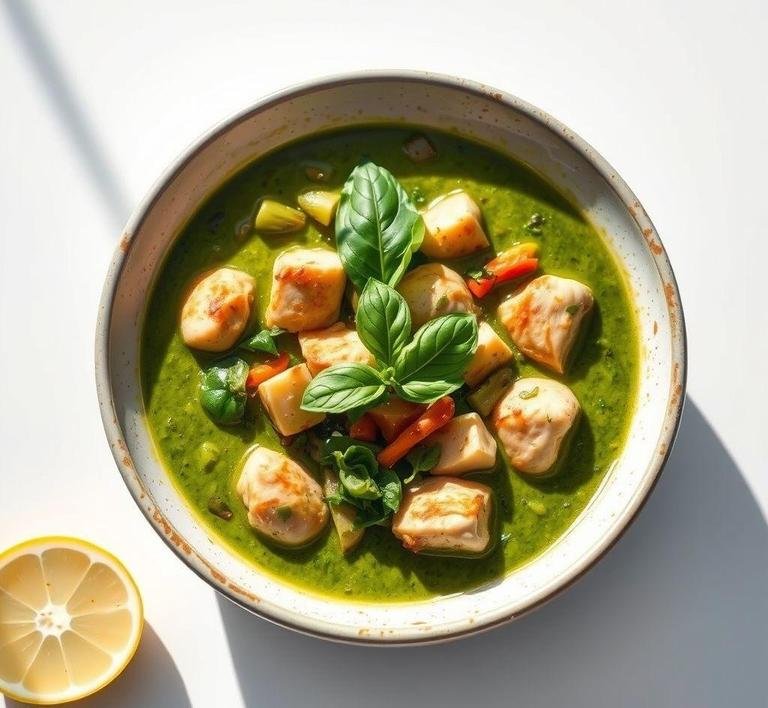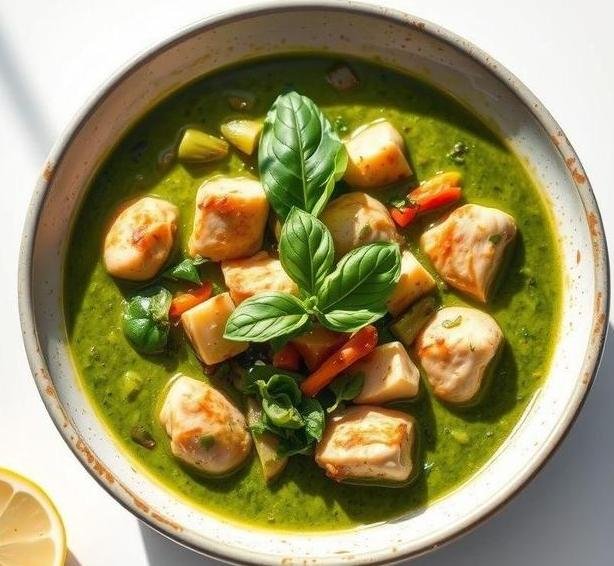Mary Berry’s Thai Green Curry is a vibrant, fragrant, and flavorful dish that beautifully blends the fresh, zesty flavors of Thai cuisine with the warmth and comfort of a hearty curry. Created by the famous British chef and television personality Mary Berry, this dish stands out for its balance of spicy, sweet, sour, and savory flavors, all of which are hallmark characteristics of Thai curries.
What makes Mary Berry’s version unique is her simplified approach to an otherwise complex dish. While authentic Thai green curry can involve various intricate techniques and multiple ingredients, Mary’s recipe focuses on creating a restaurant-worthy dish with accessible ingredients and straightforward cooking methods. The curry is typically made with a base of fresh green curry paste, coconut milk, and a variety of vegetables, protein (like chicken, prawns, or tofu), and aromatic herbs like kaffir lime leaves, basil, and cilantro.
The beauty of this dish lies not just in the complexity of flavors but in its versatility-Mary’s Thai Green Curry can be tailored to suit different tastes, whether you like it extra spicy or a bit milder, and can accommodate various dietary preferences like vegetarian, vegan, or gluten-free diets.
Mary Berry’s Thai Green Curry Recipe
Ingredients Needed

The ingredients for Mary Berry’s Thai Green Curry are designed to create a harmonious balance of flavors. Here’s a detailed list of what you’ll need:
1. Green Curry Paste
- The base of this curry, and the key to its distinct flavor. You can either make your own paste using fresh ingredients like green chilies, garlic, lemongrass, ginger, lime zest, and shrimp paste, or use a store-bought version for convenience. Mary’s recipe often uses a jarred version to save time without sacrificing too much flavor.
2. Coconut Milk
- Coconut milk provides the curry with a rich, creamy texture that balances the heat of the curry paste. It’s essential to get a full-fat coconut milk to achieve that silky consistency and luxurious mouthfeel.
3. Protein (Chicken, Prawns, Or Tofu)
- Mary’s Thai Green Curry recipe usually features chicken, but you can easily swap this out for prawns or tofu depending on your preferences or dietary restrictions. The protein soaks up all the flavors from the curry paste, enhancing the dish’s overall richness.
4. Vegetables
- Common vegetables in Thai green curry include bell peppers, carrots, and zucchini. You may also add bamboo shoots, baby corn, or eggplant for a more authentic touch. These vegetables provide a mix of texture, color, and a mild sweetness that complements the spicy curry.
5. Aromatics
- Ingredients like garlic, ginger, and onions provide a foundational depth of flavor. These ingredients are sautéed at the beginning of the recipe to release their oils and intensify the curry’s fragrance.
6. Fresh Herbs
- Thai basil and cilantro are often used as garnishes, adding freshness and an herbal bite to the dish. Kaffir lime leaves, though not always available in every kitchen, are another traditional ingredient that contributes a citrusy tang.
7. Fish Sauce
- A crucial umami-packed ingredient in Thai cooking, fish sauce adds a salty, savory layer to the curry. If you’re avoiding fish sauce, you can substitute it with soy sauce or tamari for a vegan-friendly version.
8. Lime Juice
- Fresh lime juice enhances the overall flavor profile, bringing a sharp, refreshing sour note that cuts through the richness of the coconut milk.
9. Sugar
- A small amount of sugar (often palm sugar) helps balance out the heat and sourness, ensuring the curry has a rounded sweetness that is characteristic of Thai cuisine.
Equipment Needed
To make Mary Berry’s Thai Green Curry, you’ll need the following kitchen tools:
1. Large Frying Pan Or Wok
- A large frying pan or wok is essential for sautéing the aromatics and simmering the curry. The wok allows you to cook the ingredients evenly and gives you enough room to stir everything without overcrowding the pan.
2. Sharp Knife And Chopping Board
- A sharp knife will help you chop vegetables, protein, and herbs with ease, ensuring a smooth cooking process.
3. Wooden Spoon Or Stirring Spoon
- A wooden spoon is perfect for stirring the curry without scratching your cookware. It’s gentle on the pan and allows you to effectively mix the ingredients.
4. Measuring Spoons And Cups
- For precision when adding ingredients like fish sauce, lime juice, or sugar, measuring spoons and cups come in handy to ensure you maintain the perfect balance of flavors.
5. Lid For Simmering
- A lid helps trap the steam while the curry simmers, which helps cook the protein and vegetables thoroughly and retains all the aromatic flavors.
6. Serving Dishes
- You’ll need bowls for serving the curry, ideally with a side of jasmine rice, which complements the flavors of the curry and helps soak up the sauce.
Instructions To Make Mary Berry’s Thai Green Curry
-
Prepare The Ingredients
- Start by chopping your protein (chicken, prawns, or tofu) into bite-sized pieces.
- Slice your vegetables into uniform pieces, so they cook evenly. You can use bell peppers, carrots, zucchini, or any other vegetables you prefer.
- Finely chop the garlic, ginger, and onions. If you have fresh basil or cilantro, chop them up for garnish. If using kaffir lime leaves, shred them into fine strips.
-
Cook The Aromatics
- Heat a splash of oil in a large frying pan or wok over medium heat. Add the onions, garlic, and ginger. Sauté for about 3-5 minutes until they’re softened and fragrant.
-
Add The Green Curry Paste
- Stir in the green curry paste and cook it for 1-2 minutes. This helps release its oils and intensify the flavor. Be careful not to burn it.
-
Add The Protein And Vegetables
- Add your chopped protein and vegetables to the pan. Stir everything together to coat the ingredients in the curry paste.
-
Simmer With Coconut Milk
- Pour in the coconut milk and add a splash of water if necessary. Stir to combine. Bring the mixture to a simmer, then cover the pan with a lid. Let it cook for 15-20 minutes, or until the protein is cooked through and the vegetables are tender.
-
Season The Curry
- Add fish sauce to taste (about 1-2 tablespoons) and a tablespoon of sugar to balance the flavors. Stir well. Adjust the seasoning with lime juice to bring in a bit of brightness and acidity.
-
Final Touches
- Once the curry is cooked, give it a final taste check. Adjust seasoning with more lime juice, sugar, or fish sauce as needed.
-
Serve And Garnish
- Serve the curry hot with a bowl of jasmine rice. Garnish with fresh cilantro and basil for an aromatic finish.
Tips And Tricks
-
Make Your Own Green Curry Paste
- If you have access to fresh ingredients, consider making your own green curry paste from scratch. It’s more flavorful and aromatic compared to store-bought versions.
-
Adjust The Spice Level
- If you prefer a milder curry, use fewer green chilies in your paste or add less curry paste overall. Conversely, add more paste or extra chilies for a spicier kick.
-
Use Full-Fat Coconut Milk
- Full-fat coconut milk creates a creamy texture that is essential for achieving a luscious, velvety curry. If you opt for low-fat coconut milk, the curry may lack the richness.
-
Balance The Flavors
- Thai green curry is all about balancing spicy, sour, sweet, and salty flavors. Taste the curry as you go and adjust with lime juice (for sourness), sugar (for sweetness), fish sauce (for saltiness), and extra curry paste (for heat).
-
Vegan Version
- To make a vegan version, simply swap the protein for tofu or vegetables, and make sure to use soy sauce instead of fish sauce.
Mary Berry’s Thai Green Curry is a delightful introduction to the world of Thai cuisine, offering a flavorful and aromatic experience that will transport your taste buds straight to Southeast Asia. With the combination of fresh ingredients, balanced flavors, and straightforward cooking techniques, this dish is perfect for both novice cooks and seasoned chefs looking to make a delicious meal. Whether you’re craving a comforting dinner or an impressive dish for guests, this Thai green curry is sure to impress. It’s adaptable, easy to prepare, and packed with vibrant flavors, making it a staple in many kitchens. Enjoy the delicious harmony of spices, coconut milk, and fresh herbs in every bite!
Easy Recipe Variations For Mary Berry’s Thai Green Curry

Mary Berry’s Thai Green Curry recipe offers a vibrant, aromatic, and satisfying dish that embodies the perfect balance of heat, freshness, and creaminess. However, like any classic recipe, it’s versatile enough for you to experiment with and make your own. Below are some easy variations you can try based on dietary preferences, seasonal ingredients, or even to give the curry a new twist each time you cook it.
1. Protein Swaps
-
Chicken: The classic choice in Mary Berry’s recipe is chicken, but you can easily swap it for other proteins.
- Tofu or Tempeh: For a plant-based option, replace the chicken with tofu or tempeh. Firm tofu, when pressed and cubed, takes on the flavors of the curry wonderfully. Tempeh provides a more earthy, nutty flavor which can be an exciting twist.
- Prawns or Fish: Seafood lovers can opt for prawns or a white fish like cod or haddock. Prawns cook quickly, so add them in the last few minutes of the curry’s simmering process to avoid overcooking.
- Beef or Lamb: For a richer, more indulgent curry, beef or lamb is a great option. Slow-cooked beef shank or tender lamb can give the dish a deeper flavor profile, perfect for a more hearty meal.
2. Vegetable Additions
- Root Vegetables: Mary’s recipe allows for a lot of customization with vegetables. Adding hearty root vegetables like sweet potatoes, carrots, or parsnips will not only deepen the flavor but also add a sweet contrast to the curry’s spice.
- Mushrooms: Adding mushrooms, like shiitake or chestnut, can introduce an umami-rich flavor to the dish, which works especially well if you’re substituting meat with plant-based ingredients.
- Bell Peppers & Aubergines: These vegetables are great for absorbing the fragrant curry sauce. Use a mix of bell peppers (red, yellow, or green) and sliced aubergines (eggplants) for a lovely balance of texture and flavor.
3. Adjusting The Spice Level
- Milder Flavor: If you prefer a milder curry, reduce the amount of green curry paste and chillies, or replace them with a more delicate red curry paste. Coconut milk and sugar will help balance out the heat while maintaining the essence of the dish.
- Extra Heat: For those who love a good kick, consider adding a few extra Thai bird’s eye chillies, or even a splash of Sriracha sauce or chili oil to intensify the spice.
4. Changing The Base Liquid
- Coconut Milk Substitutes: While coconut milk is the classic base for a Thai curry, you can experiment with variations such as full-fat coconut cream for an even richer taste. For a lighter version, try using coconut water or even a vegetable stock to lower the fat content while still retaining some of the curry’s tropical notes.
- Yogurt: For a creamier, tangier variation, add a spoonful of Greek yogurt to the curry at the end of cooking. This will create a slightly different texture and flavor profile, giving the dish a hint of sourness that balances out the spice.
5. Herb And Garnish Options
- Cilantro and Basil: Fresh herbs are a key component in Thai cuisine, so be sure to garnish your curry with fresh cilantro (coriander) leaves and Thai basil for a burst of herbal freshness.
- Lime Zest and Juice: Add lime zest or a squeeze of lime juice right before serving to brighten up the curry and cut through the richness of the coconut milk.
These variations allow you to tailor Mary Berry’s Thai Green Curry to suit your taste preferences, dietary restrictions, or whatever ingredients you have on hand. The beauty of this dish lies in its flexibility and ability to accommodate a wide range of flavors and textures.
Storing Leftovers
If you’ve made a large batch of Mary Berry’s Thai Green Curry or simply have some leftover, don’t worry-this dish stores well and can be enjoyed again later. Here are some tips for properly storing and reheating your curry to maintain its taste and texture:
1. Cool Down Quickly
- Allow the curry to cool down at room temperature for about 30 minutes before transferring it to storage containers. This helps prevent the growth of harmful bacteria and ensures the curry stays safe to eat. Avoid letting it sit out for too long (ideally not more than 2 hours).
2. Storage Containers
- Use airtight containers for storing leftovers. Glass containers are particularly useful because they don’t absorb odors and can be microwaved directly. For smaller portions, consider portioning out the curry into individual containers, making it easier to reheat just the amount you need.
3. Refrigeration
- Store your curry in the fridge if you plan to eat it within the next 2-3 days. The curry will continue to develop flavor as it sits, so leftovers may actually taste even better the next day.
4. Freezing
- If you want to store the curry for a longer period, freezing is a great option. The curry will keep in the freezer for up to 3 months. However, note that the texture of the coconut milk may change slightly after freezing and reheating, but the flavor will still be excellent. To freeze, let the curry cool completely, then transfer it to freezer-safe bags or containers. Make sure to leave some space at the top of the container, as liquids expand when frozen.
5. Reheating
- Reheat your curry gently on the stove or in the microwave. If reheating from frozen, it’s best to let the curry thaw in the fridge overnight before reheating. When reheating on the stove, add a splash of water or coconut milk to loosen the curry if it’s too thick. Stir often to ensure even heating.
By following these simple guidelines, you can enjoy Mary Berry’s Thai Green Curry long after the original cooking session, with flavors that remain vibrant and delicious.
What To Eat With Mary Berry’s Thai Green Curry?
Mary Berry’s Thai Green Curry is already a filling and flavorful dish on its own, but pairing it with the right sides can elevate the entire meal. Here are some ideas for what to serve alongside the curry to complement its bold and aromatic flavors.
1. Steamed Jasmine Rice
- The quintessential pairing for Thai curry, steamed jasmine rice provides a neutral, fragrant base that soaks up the curry sauce beautifully. You can also serve it with brown rice for a heartier option, or even coconut rice for extra flavor.
2. Naan Or Roti
- If you want to add a more substantial, bread-based side, try serving your curry with warm naan or roti. The soft, pillowy texture of naan is perfect for scooping up the creamy curry and adds a satisfying carb element to your meal.
3. Thai-Style Papaya Salad
- To balance out the rich, creamy curry, a tangy, fresh Thai-style papaya salad (som tam) is a wonderful accompaniment. The crunchy papaya, peanuts, and lime dressing will provide a refreshing contrast to the curry’s heat and depth.
4. Sautéed Greens
- Lightly sautéed greens such as spinach, bok choy, or kale with garlic and a dash of soy sauce make a great side dish. The slight bitterness of the greens complements the richness of the curry and helps balance out the flavors.
5. Pickled Vegetables
- Pickled vegetables like daikon radish or quick-pickled cucumbers bring a zesty, refreshing element to the meal. Their acidity helps cut through the coconut milk’s creaminess and refreshes your palate between bites of the curry.
6. Crispy Prawn Crackers
- For a bit of crunch, serve your Thai Green Curry with crispy prawn crackers. These add texture and a light seafood flavor that enhances the overall experience of the dish.
These side options not only complement the flavor profile of Mary Berry’s Thai Green Curry, but they also add variety and texture to the meal, making it feel complete and satisfying.
Conclusion
Mary Berry’s Thai Green Curry is a wonderfully adaptable dish, bringing together the warmth and depth of Thai flavors in a delicious, comforting way. Its versatility allows you to experiment with different proteins, vegetables, and spice levels, making it easy to customize based on personal preference or dietary requirements.
Storing leftovers is simple, and the dish keeps its vibrant flavor when properly stored and reheated. Pairing it with sides like jasmine rice, naan, or a refreshing papaya salad ensures that every bite is as satisfying as the last.
FAQs
What Are The Key Ingredients In Mary Berry’s Thai Green Curry Recipe?
Mary Berry’s Thai Green Curry features a combination of fragrant herbs and spices typical of Thai cuisine. The key ingredients include chicken (or your choice of protein), coconut milk, green curry paste, garlic, ginger, lime leaves, fish sauce, and brown sugar. Fresh vegetables like bell peppers, baby corn, and bamboo shoots are often added for extra texture and flavor. It’s essential to use high-quality curry paste and coconut milk to achieve the authentic, creamy, and aromatic flavors.
Can I Make Mary Berry’s Thai Green Curry Recipe Vegetarian?
Yes, Mary Berry’s Thai Green Curry can easily be adapted for a vegetarian or vegan diet. Simply replace the chicken with tofu, tempeh, or a selection of vegetables such as sweet potatoes, mushrooms, and cauliflower. For the sauce, ensure you’re using a plant-based coconut milk and replace fish sauce with soy sauce or a vegan-friendly alternative. The rest of the ingredients, like curry paste and spices, remain the same.
How Spicy Is Mary Berry’s Thai Green Curry, And Can I Adjust The Heat Level?
Mary Berry’s Thai Green Curry is mildly spicy, with a balance of heat from the green curry paste and the sweetness from the coconut milk. If you prefer a milder version, you can reduce the amount of curry paste or omit some of the seeds. For more heat, you can add extra green chilies or use a spicier curry paste. The dish is customizable, so you can easily adjust the spice level to your taste by tweaking the amount of curry paste or adding chili flakes.


